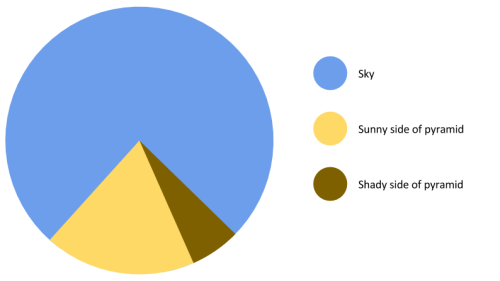Speaking Of Pretty Flowers, May I Present To You The “Eighteen Scholars”, The Flower Of My Heart-a


Speaking of pretty flowers, may I present to you the “Eighteen Scholars”, the flower of my heart-a variation of Camellia japonica L. Its uniqueness lies in the layers and layers of petals-one flower can hold as much as 130 petals.
Named “Eighteen Scholars” in Chinese because at the most, one bush can have up to eighteen of these pretty darlings :3
More Posts from Jupyterjones and Others
Regarding Fractals and Non-Integral Dimensionality
Alright, I know it’s past midnight (at least it is where I am), but let’s talk about fractal geometry.
Fractals
If you don’t know what fractals are, they’re essentially just any shape that gets rougher (or has more detail) as you zoom in, rather than getting smoother. Non-fractals include easy geometric shapes like squares, circles, and triangles, while fractals include more complex or natural shapes like the coast of Great Britain, Sierpinski’s Triangle, or a Koch Snowflake.

Fractals, in turn, can be broken down further. Some fractals are the product of an iterative process and repeat smaller versions of themselves throughout them. Others are more natural and just happen to be more jagged.

Fractals and Non-Integral Dimensionality
Now that we’ve gotten the actual explanation of what fractals are out of the way, let’s talk about their most interesting property: non-integral dimensionality. The idea that fractals do not actually have an integral dimension was originally thought up by this guy, Benoit Mandelbrot.

He studied fractals a lot, even finding one of his own: the Mandelbrot Set. The important thing about this guy is that he realized that fractals are interesting when it comes to defining their dimension. Most regular shapes can have their dimension found easily: lines with their finite length but no width or height; squares with their finite length and width but no height; and cubes with their finite length, width, and height. Take note that each dimension has its own measure. The deal with many fractals is that they can’t be measured very easily at all using these terms. Take Sierpinski’s triangle as an example.

Is this shape one- or two-dimensional? Many would say two-dimensional from first glance, but the same shape can be created using a line rather than a triangle.

So now it seems a bit more tricky. Is it one-dimensional since it can be made out of a line, or is it two-dimensional since it can be made out of a triangle? The answer is neither. The problem is that, if we were to treat it like a two-dimensional object, the measure of its dimension (area) would be zero. This is because we’ve technically taken away all of its area by taking out smaller and smaller triangles in every available space. On the other hand, if we were to treat it like a one-dimensional object, the measure of its dimension (length) would be infinity. This is because the line keeps getting longer and longer to stretch around each and every hole, of which there are an infinite number. So now we run into a problem: if it’s neither one- nor two-dimensional, then what is its dimensionality? To find out, we can use non-fractals
Measuring Integral Dimensions and Applying to Fractals
Let’s start with a one-dimensional line. The measure for a one-dimensional object is length. If we were to scale the line down by one-half, what is the fraction of the new length compared to the original length?

The new length of each line is one-half the original length.
Now let’s try the same thing for squares. The measure for a two-dimensional object is area. If we were to scale down a square by one-half (that is to say, if we were to divide the square’s length in half and divide its width in half), what is the fraction of the new area compared to the original area?

The new area of each square is one-quarter the original area.
If we were to try the same with cubes, the volume of each new cube would be one-eighth the original volume of a cube. These fractions provide us with a pattern we can work with.
In one dimension, the new length (one-half) is equal to the scaling factor (one-half) put to the first power (given by it being one-dimensional).
In two dimensions, the new area (one-quarter) is equal to the scaling factor (one-half) put to the second power (given by it being two-dimensional).
In three dimensions, the same pattern follows suit, in which the new volume (one-eighth) is equivalent to the scaling factor (one-half) put to the third power.
We can infer from this trend that the dimension of an object could be (not is) defined as the exponent fixed to the scaling factor of an object that determines the new measure of the object. To put it in mathematical terms:

Examples of this equation would include the one-dimensional line, the two-dimensional square, and the three-dimensional cube:
½ = ½^1
¼ = ½^2
1/8 = ½^3
Now this equation can be used to define the dimensionality of a given fractal. Let’s try Sierpinski’s Triangle again.

Here we can see that the triangle as a whole is made from three smaller versions of itself, each of which is scaled down by half of the original (this is proven by each side of the smaller triangles being half the length of the side of the whole triangle). So now we can just plug in the numbers to our equation and leave the dimension slot blank.
1/3 = ½^D
To solve for D, we need to know what power ½ must be put to in order to get 1/3. To do this, we can use logarithms (quick note: in this case, we can replace ½ with 2 and 1/3 with 3).
log_2(3) = roughly 1.585
So we can conclude that Sierpinski’s triangle is 1.585-dimensional. Now we can repeat this process with many other fractals. For example, this Sierpinski-esque square:

It’s made up of eight smaller versions of itself, each of which is scaled down by one-third. Plugging this into the equation, we get
1/8 = 1/3^D
log_3(8) = roughly 1.893
So we can conclude that this square fractal is 1.893-dimensional.
We can do this on this cubic version of it, too:

This cube is made up of 20 smaller versions of itself, each of which is scaled down by 1/3.
1/20 = 1/3^D
log_3(20) = roughly 2.727
So we can conclude that this fractal is 2.727-dimensional.
Permutations
Figuring out how to arrange things is pretty important.
Like, if we have the letters {A,B,C}, the six ways to arrange them are: ABC ACB BAC BCA CAB CBA
And we can say more interesting things about them (e.g. Combinatorics) another great extension is when we get dynamic
Like, if we go from ABC to ACB, and back…

We can abstract away from needing to use individual letters, and say these are both “switching the 2nd and 3rd elements,” and it is the same thing both times.
Each of these switches can be more complicated than that, like going from ABCDE to EDACB is really just 1->3->4->2->5->1, and we can do it 5 times and cycle back to the start

We can also have two switches happening at once, like 1->2->3->1 and 4->5->4, and this cycles through 6 times to get to the start.

Then, let’s extend this a bit further.
First, let’s first get a better notation, and use (1 2 3) for what I called 1->2->3->1 before.
Let’s show how we can turn these permutations into a group.
Then, let’s say the identity is just keeping things the same, and call it id.
And, this repeating thing can be extended into making the group combiner: doing one permutation and then the other. For various historical reasons, the combination of permutation A and then permutation B is B·A.
This is closed, because permuting all the things and then permuting them again still keeps 1 of all the elements in an order.
Inverses exist, because you just need to put everything from the new position into the old position to reverse it.
Associativity will be left as an exercise to the reader (read: I don’t want to prove it)



Geometry and Divnity
Omnipresence
The Point
Divinity is present in every aspect of natural order and causality dimensions. It is part of the material world through various holistic and messianic incarnations, being at the same time a component of human thought and action. This kind of omnipresence is logical possible through the classical definition of a geometrical point, that is part of the entire space but does not occupy any of it.
Trinity
The Borromean Rings
While distinct and at the same time considered to be one in all else, the Three Divine Persons are sometimes represented by the Borromean Rings: no two of the three rings are linked with each other,but nonetheless all three are linked.
Divinity
Harmonic Proportion
The harmonic state of an element is associated with beauty, given by the equilibrium of its components. Nature is being perceived as beautiful, and its creator as good - inevitable and inherently in harmony with its creation.


Interesting submission rk1232! Thanks for the heads up! :D :D

Weirdly anti-millennial articles have scraped the bottom of the barrel so hard that they are now two feet down into the topsoil
People think coding / debugging means highly concentrated furious typing, but mostly it’s just angrily staring at the screen for long periods of time waiting for the problem to solve itself






The 21 Card Trick created in Python.
See how it works and read a little more about it here: [x]
Feel free to ask any questions you may have. :)


#beingacomputerprogrammingmajor : Testing out html scripts on Pokemon Go and finding out it actually works.
-
 tori-artemis liked this · 4 weeks ago
tori-artemis liked this · 4 weeks ago -
 wecanseethemadness reblogged this · 1 month ago
wecanseethemadness reblogged this · 1 month ago -
 earthismyheaven reblogged this · 1 month ago
earthismyheaven reblogged this · 1 month ago -
 m-e-f-5 liked this · 2 months ago
m-e-f-5 liked this · 2 months ago -
 greyscalegrey liked this · 2 months ago
greyscalegrey liked this · 2 months ago -
 jewishfeminist liked this · 2 months ago
jewishfeminist liked this · 2 months ago -
 wintink liked this · 2 months ago
wintink liked this · 2 months ago -
 victoriaaa liked this · 2 months ago
victoriaaa liked this · 2 months ago -
 machimachilegends reblogged this · 3 months ago
machimachilegends reblogged this · 3 months ago -
 bunnycharms liked this · 3 months ago
bunnycharms liked this · 3 months ago -
 thesolitarycat reblogged this · 3 months ago
thesolitarycat reblogged this · 3 months ago -
 thesolitarycat liked this · 3 months ago
thesolitarycat liked this · 3 months ago -
 agridulceposts reblogged this · 3 months ago
agridulceposts reblogged this · 3 months ago -
 icebitch101 reblogged this · 4 months ago
icebitch101 reblogged this · 4 months ago -
 icebitch101 liked this · 4 months ago
icebitch101 liked this · 4 months ago -
 thebrofriends liked this · 4 months ago
thebrofriends liked this · 4 months ago -
 scorpio-wife liked this · 5 months ago
scorpio-wife liked this · 5 months ago -
 majorsarcasm19 liked this · 5 months ago
majorsarcasm19 liked this · 5 months ago -
 imallaboutthatgayshit reblogged this · 5 months ago
imallaboutthatgayshit reblogged this · 5 months ago -
 imallaboutthatgayshit liked this · 5 months ago
imallaboutthatgayshit liked this · 5 months ago -
 realsadmagician liked this · 5 months ago
realsadmagician liked this · 5 months ago -
 mistwolfdeity reblogged this · 5 months ago
mistwolfdeity reblogged this · 5 months ago -
 mistwolfdeity liked this · 5 months ago
mistwolfdeity liked this · 5 months ago -
 torrentialslide liked this · 5 months ago
torrentialslide liked this · 5 months ago -
 mijucats reblogged this · 5 months ago
mijucats reblogged this · 5 months ago -
 sheschill liked this · 5 months ago
sheschill liked this · 5 months ago -
 tintafugaz liked this · 5 months ago
tintafugaz liked this · 5 months ago -
 empireroyals liked this · 6 months ago
empireroyals liked this · 6 months ago -
 digitalewhiterrrabit liked this · 6 months ago
digitalewhiterrrabit liked this · 6 months ago -
 sh-shisoul liked this · 7 months ago
sh-shisoul liked this · 7 months ago -
 sirensscrapss reblogged this · 7 months ago
sirensscrapss reblogged this · 7 months ago -
 ladamelou liked this · 7 months ago
ladamelou liked this · 7 months ago -
 ahmed-ahmeds-posts liked this · 7 months ago
ahmed-ahmeds-posts liked this · 7 months ago -
 lilicalen liked this · 7 months ago
lilicalen liked this · 7 months ago -
 kashiismagic reblogged this · 7 months ago
kashiismagic reblogged this · 7 months ago -
 blvckxmith liked this · 7 months ago
blvckxmith liked this · 7 months ago -
 inked-paws liked this · 7 months ago
inked-paws liked this · 7 months ago -
 sunrisecosmos reblogged this · 7 months ago
sunrisecosmos reblogged this · 7 months ago -
 verywombatzonkpurse liked this · 7 months ago
verywombatzonkpurse liked this · 7 months ago -
 champagneblond10 liked this · 7 months ago
champagneblond10 liked this · 7 months ago -
 moonstruckmariner liked this · 8 months ago
moonstruckmariner liked this · 8 months ago -
 themisadventuresofem reblogged this · 8 months ago
themisadventuresofem reblogged this · 8 months ago -
 manycoloureddays reblogged this · 8 months ago
manycoloureddays reblogged this · 8 months ago -
 blkstones reblogged this · 8 months ago
blkstones reblogged this · 8 months ago -
 blkstones liked this · 8 months ago
blkstones liked this · 8 months ago -
 nixnbruises liked this · 8 months ago
nixnbruises liked this · 8 months ago -
 dizzypplbecomeblurry liked this · 8 months ago
dizzypplbecomeblurry liked this · 8 months ago -
 dandelionjack liked this · 8 months ago
dandelionjack liked this · 8 months ago -
 theabnormalbrain liked this · 8 months ago
theabnormalbrain liked this · 8 months ago


